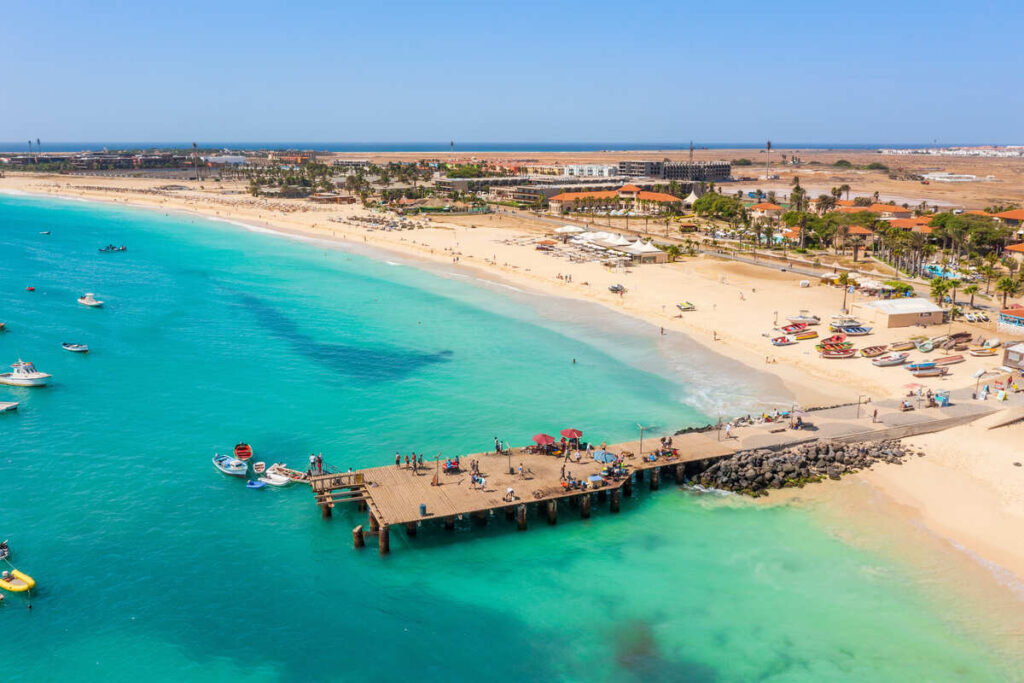No products in the cart.
Travel Guide
Move Over Maldives! This Paradise Island With White Sand Beaches Is Breaking Tourism Records
When you think of remote tropical islands surrounded by turquoise seas and home to luxury all-inclusive resorts, the Maldives are probably at the top of your head.
Known precisely for being less accessible than all your usual Caribbean hotspots—thus, more exclusive—the Indian Ocean country is seen by many as the ultimate sunny getaway:
People will save up for years to spend a single week lounging on its paradisaical beaches.
But what if we told there’s an even more offbeat Maldives dupe that’s not as expensive, and despite its relative anonymity, at least among Americans, has been rising fast in popularity lately?

The Maldives Alternative You’ve Never Even Heard About
Last year, the lesser-known island-nation of Cape Verde, lying off the coast of West Africa, has set new tourism records, hosting over 1.2 million guests.
Though it may not seem like much, this is a country that, similarly to the Maldives, only has about 522,000 inhabitants.
For those of you who are unfamiliar with the country, you should know Cape Verde comprises 10 main islands, scattered loosely in an archipelago in the Atlantic Ocean.
Its official language is Portuguese, by virtue of having been a Portuguese colony, and its culture is largely informed by a mix of Southern European, West African, and even Brazilian influences.
Let’s talk islands:


An Island-Hopping Paradise
The Maldives comparisons likely arise from the island of Sal (Portuguese for Salt), a paradisaical gem surrounded by the turquoise-most seas you’ve ever seen, and where powdered-sugar, white sands extend for miles on end.
Sal is primarily a resort destination, with its hotel-lined beachfront and plethora of beaches.
Staying in the main town, Santa Maria, a small village by any means, with a laid-back atmosphere and a big choice of seafood restaurants, you should expect to pay between $40 (for a one-bedroom holiday rental apartment), and $201 (for an all-inclusive hotel like Meliá).
As you might have noticed, even a luxurious beach getaway in Cape Verde, or Sal specifically, is unlikely to hurt your wallet, with the average price of hotels set at $133, compared to the Maldives’ much-pricier $234.


On top of accommodation, food in Cape Verde is generally affordable: ordering cachupa, a hearty stew of corn, beans, veggies and meat, from a local eatery will cost you around 550 Cape Verdean escudos, or approximately $5.51, while a pint of beer is an equally-cheap $3—3.76.
Granted, you won’t find the latter’s stunning rustic villas built on the water, connected by wooden pathways, but if it’s simply sunshine and relaxation you’re after, not the photo ops, it leaves nothing to be desired.
Cape Verde Is More Diverse Than The Maldives
Plus, Cape Verde offers a lot more diversity than the Maldives ever could.


The Maldives has many more islands, yet they’re largely similar in nature: they all have pristine beaches, vibrant-colored coral reefs, and crystalline seas. Unless you’ve booked yourself a resort with a wide range of amenities, it gets boring after a day or two.
Over in Cape Verde, the beaches of Sal, as dreamy as they may be, are not the only attraction around here:
For desert-like landscapes and even more secluded sandy beaches, Boa Vista is an offbeat island catering primarily to wellness-seekers and home to a limited number of guesthouses.
Staying in a single room at the privately-managed B&B Salinas, in Sal Rei, only a few steps from the beach, will run you up a mere $34-a-night.


In Santo Antão, the scenery is dramatically different: the sand-filled plains give way to towering, lush green mountains, traversed with hiking trails that lead to quaint, centuries-old villages that have barely seen the passing of time.
In short, it’s a nature lover’s paradise, and if you’ve ever been to Madeira, in Portugal, and ended up falling in love with it, you’ll feel no different towards its little brother.
Volcanic Landscapes & Colonial Architecture
Brava, on the other hand, has a bit of both worlds: it boasts pristine coves bathed by crystal-clear seas, rugged coastal drives, and flower-clad hills—it’s no wonder it’s called Island of Flowers.


Fogo (Portuguese for ‘fire’) has surreal volcanic landscapes, including a still-very-active Pico do Fogo, low hills dotted with colonial-era coffee plantations, and black-sand beaches (São Filipe Beach, a short drive from the namesake town, is particularly scenic).
Finally, for the culture buffs among us, you’ll find a beautifully-preserved colonial-era capital in Praia, located on Santiago Island: the Old Town, or Cidade Velha, is a petite version of Lisbon without the crowds, and the local food scene is simply unparalleled.
For Portuguese-inspired sweets, you should pay the hugely-popular Pão de Açucar bakery a visit (best pastel de nata we’ve ever tried outside Portugal).


For the all-you-can-eat Brazilian-style barbecue, Churrascaria Pirata is a no-frills rodizio restaurant featuring a variety of grilled meats.
Finally, if you’re craving a taste of native cuisine, don’t miss out on the traditional Kaza Katxupa, which features a signature corn soup and freshly caught fish doused in West African spices.
Is Cape Verde Cheaper & Easier To Get To Than The Maldives?
It can be, but only if you play it smart.
Much like the Maldives, getting to Cape Verde from the United States can be a bit tricky, not exactly because it is incredibly remote (not at all), but due to the absence of direct flights.


In the case of the Maldives, flights can take anywhere from 18 to a whopping 30 hours, depending on your U.S. departure point, and involve connections in one or more countries in Asia or the Middle East.
In the case of Cape Verde, it is in fact way more accessible, especially if you’re flying from the East Coast.
Once again, it lies off the coast of West Africa, and if you flew a straight line from any island Cape Verde, all the way across the Atlantic, you’d end up somewhere like Puerto Rico, or even Central America.
America may not have nonstop flights to Cape Verde, but once you get to Europe, a multitude of options are laid out before you:


Remember, Cape Verde is an up-and-coming sunny getaway for Europeans, and numerous European airlines offer cheap flights to the islands of Santiago and Sal from as little as $212 one-way.
Flying from New York to Paris (Charles de Gaulle), or Lisbon (LIS), two of the best-connected hubs for flying to Cape Verde, you can then change flights, either to Amílcar Cabral International Airport (SID) in Sal, or Nelson Mandela International Airport (RAI) in Praia.
It’s been a tricky world to navigate now that entry rules are tightening across the board, but the good news is, Cape Verde continues to welcome Americans visa-free, so long as they’re visiting as tourists, and for not longer than 30 days.
Make sure you bring a valid passport with enough blank pages, and proof of outbound or return tickets in order to ensure a smooth border control experience.
Ready For Your Trip? Check The Latest Entry Requirements For Your Destination Here
↓ Elevate Your Travel↓
Sign Up Now For Travel Off Path Premium! No ads, VIP Content, Personal Travel Concierge, Huge Savings, Daily Deals, Members Forum & More!


✈️Join Our Travel Off Path Community Forum: Where travelers unite, ask questions, share experiences and even find like-minded travel buddies!
SUBSCRIBE TO OUR LATEST POSTS
Enter your email address to subscribe to Travel Off Path’s latest breaking travel news, straight to your inbox.
This article originally appeared on TravelOffPath.com
Opinions expressed here are the author’s alone, not those of any bank, credit card issuer, hotel, airline, or other entity. This content has not been reviewed, approved or otherwise endorsed by any of the entities included within the post.

